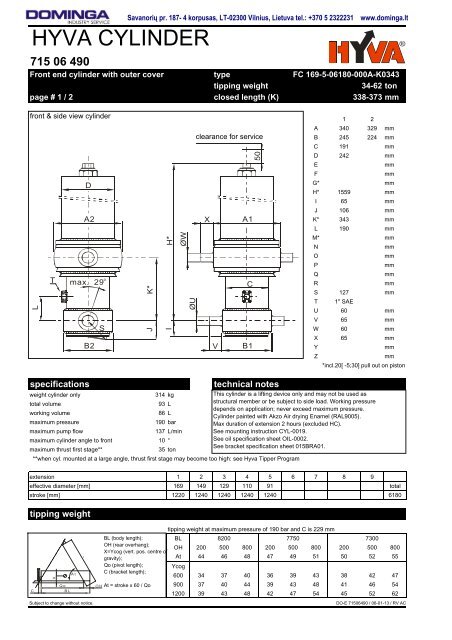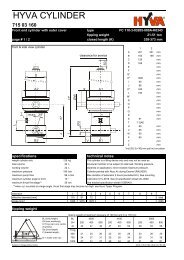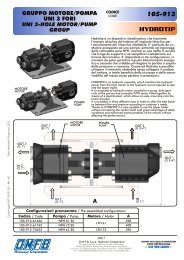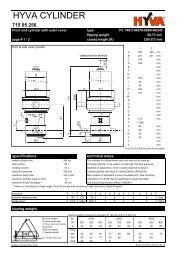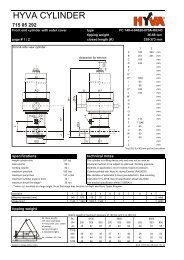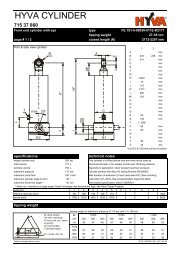FC 169-5-06180-000A-K0343 - dominga.lt
FC 169-5-06180-000A-K0343 - dominga.lt
FC 169-5-06180-000A-K0343 - dominga.lt
You also want an ePaper? Increase the reach of your titles
YUMPU automatically turns print PDFs into web optimized ePapers that Google loves.
HYVA CYLINDERSavanorių pr. 187- 4 korpusas, LT-02300 Vilnius, Lietuva tel.: +370 5 2322231www.<strong>dominga</strong>.<strong>lt</strong>715 06 490Front end cylinder with outer cover type <strong>FC</strong> <strong>169</strong>-5-<strong>06180</strong>-<strong>000A</strong>-<strong>K0343</strong>tipping weight34-62 tonpage # 1 / 2 closed length (K) 338-373 mmfront & side view cylinderDA2T max. 29 oLSB2K*JIH*ØWØUclearance for serviceX A1CV B1501 2A 340 329 mmB 245 224 mmC 191 mmD 242 mmEmmFmmG* mmH* 1559 mmI 65 mmJ 106 mmK* 343 mmL 190 mmM* mmNmmOmmPmmQmmRmmS 127 mmT 1" SAEU 60 mmV 65 mmW 60 mmX 65 mmYmmZmm*incl.20[ -5;30] pull out on pistonspecificationstechnical notesweight cylinder only314 kgThis cylinder is a lifting device only and may not be used astotal volume93 Lstructural member or be subject to side load. Working pressuredepends on application; never exceed maximum pressure.working volume86 LCylinder painted with Akzo Air drying Enamel (RAL9005).maximum pressure190 barMax duration of extension 2 hours (excluded HC).maximum pump flow137 L/minSee mounting instruction CYL-0019.maximum cylinder angle to front 10 °See oil specification sheet OIL-0002.maximum thrust first stage**35 tonSee bracket specification sheet 015BRA01.**when cyl. mounted at a large angle, thrust first stage may become too high: see Hyva Tipper Programextension 1 2 3 4 5 6 7 8 9effective diameter [mm] <strong>169</strong> 149 129 110 91 totalstroke [mm] 1220 1240 1240 1240 1240 6180tipping weightCXQoBLAtSubject to change without notice.OHtipping weight at maximum pressure of 190 bar and C is 229 mmBL (body length);BL 8200 7750 7300OH (rear overhang);OH 200 500 800 200 500 800 200 500 800X=Ycog (vert. pos. centre ofgravity);At 44 46 48 47 49 51 50 52 55Qo (pivot length);C (bracket length);Ycog600 34 37 40 36 39 43 38 42 47At = stroke x 60 / Qo 900 37 40 44 39 43 48 41 46 541200 39 43 48 42 47 54 45 52 62DO-E 71506490 / 06-01-13 / RV AC
WWW 2009 MADRID! Poster Sessions: Friday, April 24, 2009In figure 1, we show a collection of mebs for a user John. Johnhas mu<strong>lt</strong>iple web-identities (on different sites & communicationmechanisms). John’s social network will know him through suchids. Bold lines in the figure indicate these social relationships.The MEBs contain hyperlinks to the subject_URLs which theyare about.The information shown in the dotted box includes the mu<strong>lt</strong>ipleuser identities of John and his MEB store. This information isowned by the user. Other users also have their MEB clouds.Retaining the link between the user and his content allows us toenable queries which take into account the opinion of my socialnetwork.Conceptually, a MEB gets created as a by-product of a webinteraction provided the user chooses to do so. One way of doingthis is by using a browser agent to send notifications to a centralrepository server when posting new content as suggested in [2].We have implemented MEB creation using browser plug-ins. Auser may choose to store her MEBs at the entity-site (provided thesite supports this) and/or publish it on one or more of her webpresences(blogs, facebook-page etc.). We believe that usercentricityfor MEB is important for two reasons: (a) MEBs arecreated at different websites but must be stored in a user-centeredfashion and (b) user must have absolute control over who canaccess their opinions captured in MEBs.4.3 Searching Personal Expression on SocialNetworksWe enable opinion queries of the form, given a set of people V,and a user query σ, find V’s STRAT content on σ. For e.g.assuming that John has access to Jeff’s MEB cloud, John canquery ‘what has Jeff said about the book, Harry Potter and theSorcerer Stone’.The set of people specified in V should be communication-ids e.g.‘john@gmail’ or id on a social networking site like Facebook etc.The querier may specify these ids explicitly (john@gmail) orimplicitly (‘my social network’). The specified communicationids then define how the query is routed to the target meb-cloud. Ina peer-to-peer implementation of this search, V will be an emailid.When the user types in a query (specifies V & σ), an email issent to the email-ids specified in V. If the query is allowed as peraccess-policies, the receiving client triggers a search operationover the user’s MEB clouds based on σ. Finally, the handlercollects the resu<strong>lt</strong>s of the search operation and returns them viathe same communication channel on which the request wasreceived (email in this case). At the queried end, the resu<strong>lt</strong>s maybe presented in an appropriate interface. We note the potentialdelay incurred as a function of the communication channel used.As another a<strong>lt</strong>ernative implementation, V contains a socialnetworking page URL. In this case, the query will be routed to anapplication installed on the user’s social networking page (e.g.Facebook Apps). This application will then carry out the handlerfunctions described above.Further, we envision combining MEB search resu<strong>lt</strong>s with websearch resu<strong>lt</strong>s. One approach may be to modify the link analysisalgorithms on graphs for e.g. Hubs & Authorities [3] to includethe authority conferred to a web page by a MEB-page. We cantransfer the influence of a MEB page based on its creator - thenotion here is that the meb pages may have a very low link-basedscore but the querier may value highly a friend’s opinion.Formally, for each page p in (web+meb) search resu<strong>lt</strong>s, we< p>calculate the following iteratively (a) authority score, x =< p>weighted sum of y values of pages pointing to p:< p>< q>< q>< p>x = ∑wy and (b) hub score, y = weightedq:(q,p)∈E< p>sum of x values of pages pointing to p:< p>< q>< q>y = ∑ z y . What we need now is to determineq:(p,q)∈Ethe social weight matrix W (Z will be the transpose of W).5. CURRENT STATUSWe have working prototypes to demonstrate MEB creation,sstorage & search over social networks. We are in the process ofimplementing using mebs to improve web search.6. ACKNOWLEDGEMENTSWe would like to thank Geetha Manjunath for her valuable inputs.7. REFERENCES[1] HA Kautz, B Selman, MA Shah. The Hidden Web. AIMagazine, 1997.[2] Raghu Ramakrishnan, Andrew Tomkins, Towards a PeopleWeb. Computer, Vol. 40, No. 8. (2007)[3] Kleinberg, J, Authoritative Sources in a HyperlinkedEnvironment. - Journal of the ACM, 19991218


